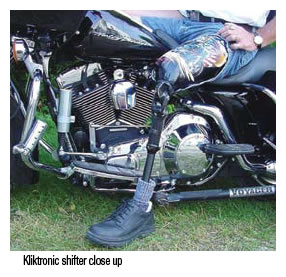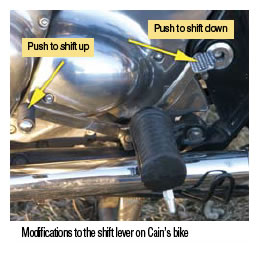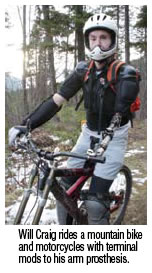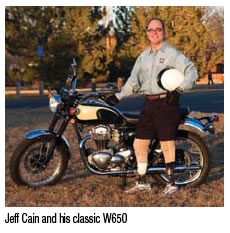Volume 16 · Issue 3 · May/June 2006 | Download PDF
Adaptive Modifications for Amputee Motorcycling
– Anonymous

The answer is an enthusiastic “Yes!” In this article, we will review common motorcycle modifications that can help an amputee rider get back on the road and, just as importantly, how to prepare yourself.
Getting Started
Getting your motorcycle ready for amputee riding isn’t necessarily difficult. You merely need to understand how the controls on the motorcycle operate and how to modify them to work with your prosthesis.
An adaptive rider’s best friend is a local cycle shop with a craftsman who is able to modify your motorcycle, because there are no formal adaptive motorcycling organizations in the U.S. The market is simply too small to find most motorcycle adaptations “off the shelf,” so you may need to customize your bike for your specific needs and abilities. Let’s start by looking at how a rider uses the controls on a motorcycle and some common modifications for amputees.
Left Leg
On a standard motorcycle, the left foot operates the gear shifter by lifting up and pushing down with the toes. Riders with a below-knee (BK) prosthesis can modify the shift lever by adding a heel extension to allow changing gears by both pushing down with the heel and pushing down at the toe position. This system already comes standard on some cruiser models like the Harley-Davidson. Alternatively, the shifter can be moved to the right side, as it used to be on older British bikes. A slick, newer option is the Kliktronic electronic shifter system. The Kliktronic is a gear changer that uses a push-button gear selector on the handlebar, connected to an electric solenoid to operate the bike’s shift lever. Gear changing is done with the left hand, and the entire kit can be moved if you change bikes.

Most motorcycles operate the real wheel brake with a toe lever on the right side. Modification options for right leg amputees include either operating a modified right brake pedal with the prosthesis, moving the brake to the left side, or mounting a second hand brake lever in tandem with the front brake lever on the handlebar. BMW and many other modern motorcycles now come with an anti-lock brake system that automatically interconnects the front and rear brakes and eliminates the need for these changes.
Above-Knee Considerations
Above-knee (AK) riders have two challenges to cope with: keeping the bike upright while stopped, and operating the side stand. Solutions for these challenges include choosing a prosthetic knee that is stable in an extended position and linking the side stand to a hand lever extender below the tank. Many AK riders eliminate these issues by riding a motorcycle with a sidecar or a trike, both of which are more stable yet allow the freedom of motorcycling.
Related Resources
American Motorcycle Association
http://www.ama-cycle.org
AmpsCanRide
http://www.mtb-amputee.com
Disabled Riders of America
http://www.dra.thewyz.com
Mert Lawwill
http://www.mertlawwill.com/merthome.html
Motorcycle Safety Foundation
http://www.msf-usa.org
National Association of Bikers with Disabilities (British)
http://www.nabd.org.uk
National Highway Traffic Safety Administration: Motorcycle Safety
http://www.nhtsa.dot.gov/people/injury/ pedbimot/motorcycle/motosafety.html
Other Options for Leg Amputees

Arm Amputees
Arm amputees, even more than leg amputees, are faced with the choice of modifying either the motorcycle or their prosthesis. Changing the motorcycle involves rerouting the standard brake, throttle or clutch controls so they can be operated with one hand. Customized prosthetic modifications allow the rider to engage the brake or clutch with a specialized terminal device designed specifically for the motorcycle. Bike kits and prosthetic solutions are available on the Internet (see Related Resources). Additional recommendations for arm amputees include a front steering dampener and using Velcro® on the glove of the prosthetic hand to assist with controlling the bike and keeping the prosthetic hand on the bars.
G
Riding a motorcycle is a thoroughly exhilarating and fun experience. But, along with the thrills come some additional risks and responsibilities. Before starting adaptive motorcycling, consider a Motorcycle Safety Foundation (MSF) class to learn the rules of the road, and check with your state motor vehicle department to find out if there are additional testing/driving requirements for adaptive riders. Buy the best helmet that is comfortable for you to wear, and wear it every time you ride. Start on side roads away from traffic, and move up to higher speeds and traffic as your skills progress.
See you on the road, and keep the shiny side up!
About the Author
Jeffrey Cain, MD, a bilateral BK amputee, is the chief of family medicine at The Children’s Hospital in Denver, Colorado. Cain is a member of the Amputee Coalition Board of Directors. In his spare time, Cain is a pilot and enjoys swimming, biking, snow skiing and water skiing. He rides a Vespa scooter for urban commuting.


